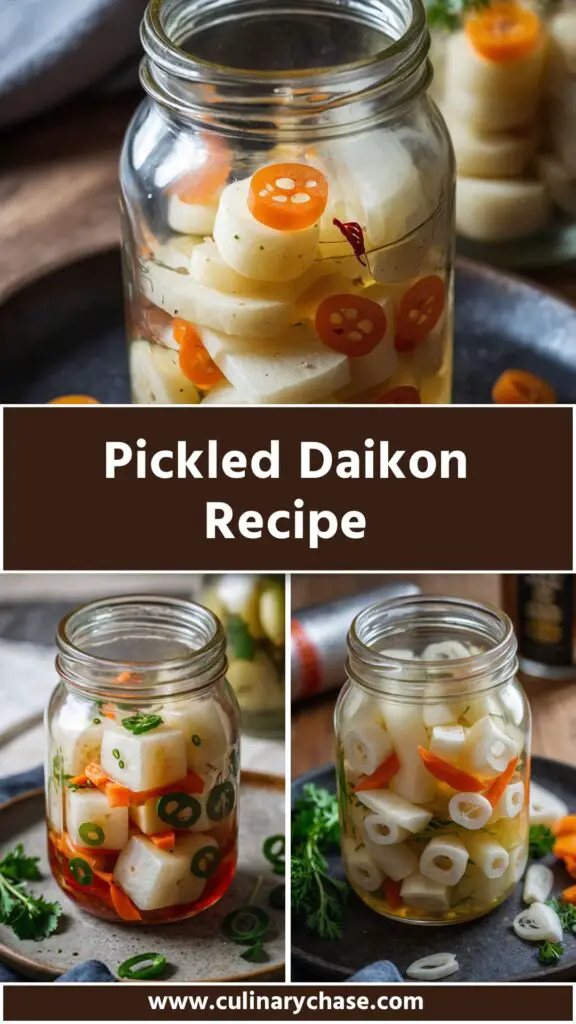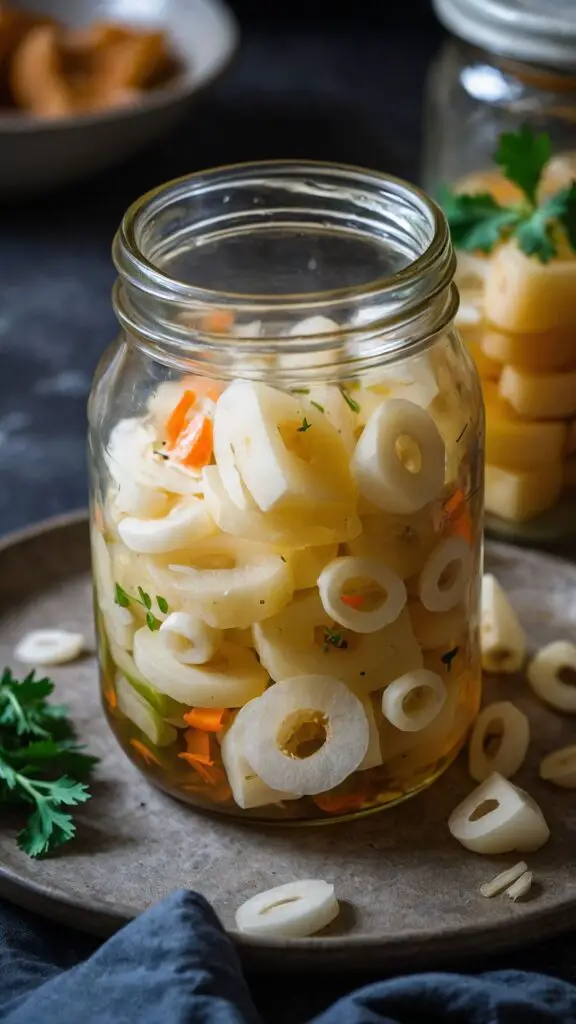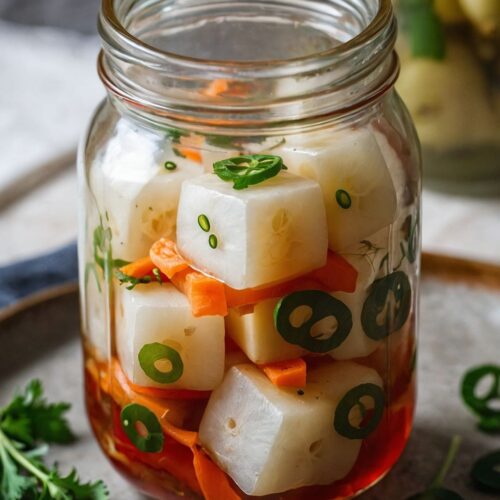Pickled Daikon – Culinary Chase
Before we dive into the delightful world of pickled daikon, let’s talk about what you can enjoy it with. Pickled daikon makes a fabulous companion for various dishes. Whether it’s served alongside sushi, in a Vietnamese banh mi sandwich, or tossed into a fresh salad, its crunchy and tangy profile complements a wide array of flavors.
I often find myself reaching for pickled daikon on a hot summer day, rolling it up with my favorite grilled meats or flaunting it in my tacos. It can also add a zesty kick to a simple bowl of rice or quinoa, making your meal both colorful and exciting.
Let’s turn our attention to crafting the perfect pickled daikon.

If you’ve never tried pickled daikon, you’re in for a tender treat. My first encounter with it was at a local Asian market. The vibrant colors and tantalizing scents drew me in. I was captivated by its crispness and the tang that seemed to dance on my taste buds.
Pickled daikon is not just a side dish; it’s an experience. It’s a reinterpretation of the radish, lifting its natural taste through the magic of brining. The beauty of this recipe lies in its simplicity, yet it delivers an explosion of flavor that can enhance any meal.
You might be wondering why more people aren’t talking about this culinary gem. Well, let me take you through the artistry of pickling daikon radish and how easy it can be to produce this refreshing condiment at home.
What is Pickled Daikon?
Pickled daikon is essentially radish preserved in a vinegar-based solution. It originates mostly from Asian cuisine, with roots in Japanese and Korean kitchens.
The daikon radish is larger and milder than its red counterpart. Once pickled, it takes on a delightful crunch and a subtle sweetness that balances well with the acidity of the vinegar.
For me, every step in the pickling process reveals the potential hidden within this humble vegetable. You can savor it in many forms, whether in salads, as a side, or even as a topping on dishes like rice, noodles, or tacos.
Flavor Profile of Pickled Daikon
Let’s get into the essence of pickled daikon. It’s a magical fusion of tangy, sweet, and slightly spicy flavors, depending on how you prepare it.
The vinegars used, combined with sugar, salt, and any added spices, create a well-rounded profile that’s hard to forget. The daikon itself offers a mild, peppery note, which complements the pickling brine beautifully.
When I crave something refreshing, pickled daikon answers that call. Each bite combines crispness with a punch of flavor, brightening up even the most mundane meals. Its ability to elevate the taste of dishes is what sets it apart.
You will also like the following Side Dishes recipes!
- Chinese Style Stir Fried Tomato With Egg Recipe
- Air Fryer Buffalo Wings
- Qdoba Mexican Grill Chips And Salsa
What Makes This Recipe Different?
You may stumble upon various recipes for pickled daikon. What makes my version special lies in the balance of flavors and the technique involved.
Unlike traditional methods that may use only sugars or the basic vinegar, I turn up the volume with fresh ginger, whole peppercorns, and a hint of chili. These ingredients infuse the daikon with depth and character.
Additionally, I’ve streamlined the process to ensure it’s not only simple but efficient. You don’t have to wait for days before you can enjoy your creation. In merely a few hours, you can taste the difference!
Ingredients You’ll Need
Here are the essential elements to gather for preparing your pickled daikon:
500 g (1.1 lb) daikon radish, peeled and sliced
250 ml (1 cup) rice vinegar
110 g (½ cup) white sugar (adjust sweetness as desired)
2 teaspoons coarse sea salt
1 small piece of fresh ginger, thinly sliced
1 slender red cayenne chili, thinly sliced (optional – for those who like a kick)
250 ml (1 cup) purified water
1 teaspoon whole black peppercorns
Make sure you have everything ready. It makes a huge difference in how smoothly the process goes!

Step-by-Step Directions
Step 1: Preparing the Daikon
Start by peeling your daikon. Using a sharp knife, slice it into thin rounds. You can also julienne it if you prefer smaller pieces. This allows for a quicker infusion of flavors later on. The daikon slices should be around 1/8 inch thick.
Step 2: Make the Brine
In a medium saucepan, combine the rice vinegar, purified water, and sugar. Next, add the coarse sea salt, thinly sliced ginger, and whole black peppercorns. If you decide to spice things up, include the cayenne chili as well.
Step 3: Heating the Mixture
Over medium heat, bring your brine to a simmer.
Stir well to ensure the sugar and salt dissolve fully. There’s something soothing about this step; as the mixture heats, it transforms into a fragrant elixir.
Step 4: Pickling the Daikon
Once the brine is ready, place the daikon slices in a heatproof jar or container.
Carefully pour the hot brine over the radishes, ensuring they’re fully submerged. If you have any leftover ingredients like ginger or chili, toss them in for extra flavor.
Step 5: Cooling and Storing
Let the jar cool to room temperature before sealing it with a lid. Once cooled, pop it into the fridge. The flavors will start to meld together within a few hours, but for the best experience, allow it to sit for at least 24 hours.
Step 6: Enjoy Your Creation!
After the waiting period, it’s go-time! Open the jar and take in that enticing aroma, then grab a slice. The crunch, the zing, and the balance of flavors will certainly leave you wanting more.
Tips on Making Pickled Daikon
Here are some key tips that might help enhance your pickled daikon experience:
Tip 1: Adjust the sweetness – If you prefer your pickles tangier, feel free to reduce the sugar. Keeping the balance is crucial so taste as you go.
Tip 2: Let it marinate longer – While it’s ready to enjoy after a few hours, waiting a few days allows the flavors to deepen. Be patient; it’ll be worth it.
Tip 3: Try different vinegars – To switch things up, experiment with apple cider vinegar or even floral vinegar for a unique twist.
Tip 4: Use a variety of spices – Don’t hesitate to toss in spices like cloves, or star anise. Each addition opens up new flavor avenues.
Tip 5: Mix up the veggies! – While this focus is on daikon, don’t shy away from adding carrots, cucumbers, or even radishes for extra color and crunch.
Nutrition Information
Per serving (about 1/2 cup):
Calories: 50
Total Fat: 0g
Sodium: 1200mg
Total Carbohydrates: 13g
Sugars: 6g
Protein: 1g
This makes pickled daikon a low-calorie companion that can fit seamlessly into most diets.
How Can I Store This Pickled Daikon Recipe?
Proper storage is vital to maintain its freshness. Keep your pickled daikon in a clean, airtight jar and store it in the fridge. It can last for up to a month, but each day brings its own charm as the flavors evolve.

Ingredient Substitutes
In case you find yourself short on any ingredients, don’t fret. Here are some substitutes:
If you don’t have rice vinegar, you can use apple cider vinegar as an alternative. It has a milder taste and pairs well with daikon.
White sugar can be replaced with honey or agave syrup for a more natural sweetener.
If you’re out of daikon, try using turnips. They have a similar texture and can yield tasty results.
In place of cayenne chili, consider using crushed red pepper flakes. It’ll add a different yet enjoyable heat level to your recipe.

Pickled Daikon
Equipment
- saucepan
- Tablespoons
Ingredients
- 500 g 1.1 lb daikon radish, peeled and sliced
- 250 ml 1 cup rice vinegar
- 110 g ½ cup white sugar (adjust sweetness as desired)
- 2 teaspoons coarse sea salt
- 1 small piece of fresh ginger thinly sliced
- 1 slender red cayenne chili thinly sliced (optional – for those who like a kick)
- 250 ml 1 cup purified water
- 1 teaspoon whole black peppercorns
Instructions
Step 1: Preparing the Daikon
- Start by peeling your daikon. Using a sharp knife, slice it into thin rounds. You can also julienne it if you prefer smaller pieces. This allows for a quicker infusion of flavors later on. The daikon slices should be around 1/8 inch thick.
Step 2: Make the Brine
- In a medium saucepan, combine the rice vinegar, purified water, and sugar. Next, add the coarse sea salt, thinly sliced ginger, and whole black peppercorns. If you decide to spice things up, include the cayenne chili as well.
Step 3: Heating the Mixture
- Over medium heat, bring your brine to a simmer.
- Stir well to ensure the sugar and salt dissolve fully. There’s something soothing about this step; as the mixture heats, it transforms into a fragrant elixir.
Step 4: Pickling the Daikon
- Once the brine is ready, place the daikon slices in a heatproof jar or container.
- Carefully pour the hot brine over the radishes, ensuring they’re fully submerged. If you have any leftover ingredients like ginger or chili, toss them in for extra flavor.
Step 5: Cooling and Storing
- Let the jar cool to room temperature before sealing it with a lid. Once cooled, pop it into the fridge. The flavors will start to meld together within a few hours, but for the best experience, allow it to sit for at least 24 hours.
Step 6: Enjoy Your Creation!
- After the waiting period, it’s go-time! Open the jar and take in that enticing aroma, then grab a slice. The crunch, the zing, and the balance of flavors will certainly leave you wanting more.
Notes
Nutrition
Frequently Asked Questions
Q1: Can I use other types of radishes?
Absolutely! While daikon is the traditional choice, feel free to try with red radishes or even black radishes. Each brings its own flavor.
Q2: How do I know if my pickled daikon has gone bad?
Look for any off smells or changes in color. If it appears slimy or you see mold, it’s time to toss it.
Q3: Can I make this recipe vegan?
Yes, this recipe is naturally vegan! All ingredients used are plant-based.
Q4: Can I serve pickled daikon to kids?
Certainly! Just adjust the heat level by omitting the chili. Many children appreciate the sweet and tangy taste.
Q5: Can I can pickled daikon for shelf storage?
Yes, you can use canning methods to store pickled daikon for longer periods. Follow proper canning procedures for safe preservation.
Conclusion
Pickled daikon is more than a condiment; it’s an adventure. Finding the time to create this dish not only enhances your meals but also ignites your culinary creativity. The infusion of flavors, the vibrant crunch, and the versatility of this simple recipe are compelling reasons to keep making it.
Whether you’re hosting a barbecue, preparing a family dinner, or just looking to upgrade your snack game, pickled daikon is sure to impress. I encourage you to put on your apron, grab your daikon, and embark on this flavorful journey. You won’t regret it—every jar is an invitation to experience the delightful nuances of taste.
